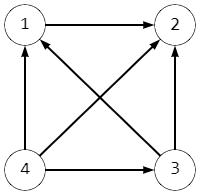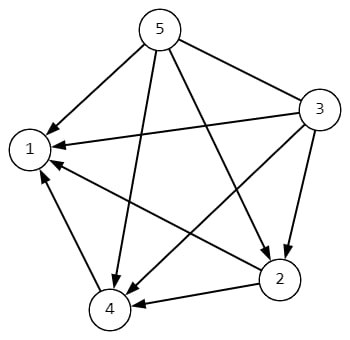| Codeforces Round 891 (Div. 3) |
|---|
| Finished |
Given two arrays $$$a$$$ and $$$b$$$, both of length $$$n$$$. Elements of both arrays indexed from $$$1$$$ to $$$n$$$. You are constructing a directed graph, where edge from $$$u$$$ to $$$v$$$ ($$$u\neq v$$$) exists if $$$a_u-a_v \ge b_u-b_v$$$.
A vertex $$$V$$$ is called strong if there exists a path from $$$V$$$ to all other vertices.
A path in a directed graph is a chain of several vertices, connected by edges, such that moving from the vertex $$$u$$$, along the directions of the edges, the vertex $$$v$$$ can be reached.
Your task is to find all strong vertices.
For example, if $$$a=[3,1,2,4]$$$ and $$$b=[4,3,2,1]$$$, the graph will look like this:
 The graph has only one strong vertex with number $$$4$$$
The graph has only one strong vertex with number $$$4$$$ The first line contains an integer $$$t$$$ ($$$1\le t\le 10^4$$$) — the number of test cases.
The first line of each test case contains an integer $$$n$$$ ($$$2 \le n \le 2\cdot 10^5$$$) — the length of $$$a$$$ and $$$b$$$.
The second line of each test case contains $$$n$$$ integers $$$a_1,a_2 \dots a_n$$$ ($$$-10^9 \le a_i \le 10^9$$$) — the array $$$a$$$.
The third line of each test case contains $$$n$$$ integers $$$b_1,b_2 \dots b_n$$$ ($$$-10^9 \le b_i \le 10^9$$$) — the array $$$b$$$.
It is guaranteed that the sum of $$$n$$$ for all test cases does not exceed $$$2\cdot 10^5$$$.
For each test case, output two lines: in the first line, output the number of strong vertices, and in the second line, output all strong vertices in ascending order.
543 1 2 44 3 2 151 2 4 1 25 2 3 3 121 22 130 2 11 3 235 7 4-2 -3 -6
1 4 2 3 5 1 2 3 1 2 3 2 2 3
The first sample is covered in the problem statement.
For the second sample, the graph looks like this:
 The graph has two strong vertices with numbers $$$3$$$ and $$$5$$$. Note that there is a bidirectional edge between vertices $$$3$$$ and $$$5$$$.
The graph has two strong vertices with numbers $$$3$$$ and $$$5$$$. Note that there is a bidirectional edge between vertices $$$3$$$ and $$$5$$$. In the third sample, the vertices are connected by a single directed edge from vertex $$$2$$$ to vertex $$$1$$$, so the only strong vertex is $$$2$$$.
In the fourth sample, all vertices are connected to each other by bidirectional edges, so there is a path from every vertex to any other vertex.
| Name |
|---|




